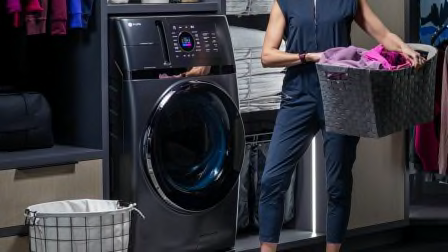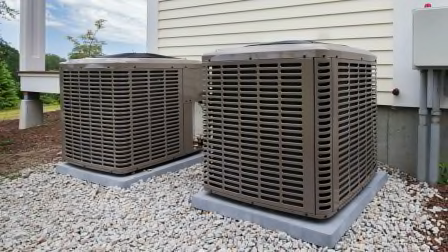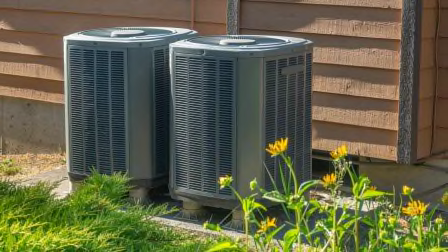Buying a Heat Pump Could Get You Thousands in Federal Tax Credits and State Rebates
The Inflation Reduction Act includes incentives for HVAC upgrades

The Inflation Reduction Act is packed with provisions to incentivize homeowners to make energy-efficiency upgrades to their home, including installing high-efficiency heating, cooling, and water-heating equipment such as fuel-conserving furnaces, boilers, and wood stoves.
But the largest credits and rebates are available for heat pumps, a high-efficiency system that heats and cools your home in place of a furnace (or boiler) and an air conditioner. When coupled with cleaner electricity sources, a heat pump can be a sustainable way to control the temperature indoors. And while older heat pumps struggled in cold climates, many of the latest models can even work well in frigid winter temperatures.
Our reporting has found that heat pumps can be more cost-effective than other heating systems over the long term. And in some parts of the country, they already cost less to install than other kinds of HVAC systems.
However, the initial purchase price of a heat pump can remain high in some areas, especially in cold climates. In a June 2022 nationally representative CR survey (PDF) of 2,103 U.S. adults, 21 percent of people who expressed they would not or might not be interested in using a heat pump in their home in the future said one reason is that "they seem expensive to buy/install."
These new incentives could make heat pump installations much more affordable. "Consumers can seriously consider a heat pump now if they’re on a limited budget," says Shanika Whitehurst, CR’s associate director of product sustainability, research, and testing.
How You Can Take Advantage of the Inflation Reduction Act
CR fills you in on which cars will qualify for the new electric vehicle tax credit. You can even get a tax credit on a used EV.
Heat Pump Provisions in the Inflation Reduction Act
If you opt to install a heat pump, you’ll be eligible for a federal tax credit for models that achieve the Consortium for Energy Efficiency’s (CEE) highest tier for efficiency.
Who Qualifies for a Heat Pump Tax Credit or Rebate
Any taxpayer would qualify for the federal tax credits.
For the tax credit program, the new incentives will apply to equipment installed on January 1, 2023 or later. (A smaller tax credit of up to $300 for a heat pump meeting the CEE’s top tier of efficiency is available for heat pumps installed during 2022.)
As for the rebate programs, Urbanek says it would be “surprising” if they turn out to apply retroactively. The rebates depend on income. Specifically:
- If your household income is less than 80 percent of your state’s median household income, you are eligible for 100 percent of the rebates available. So if you spend $10,000 on a heat pump and a heat pump water heater, you could get $9,750 back, depending on the specifics of your state’s rebate program.
- If your household income is 80 percent to 150 percent of your state’s median income, you are eligible for 50 percent of the rebates available. So for a $10,000 heat pump and heat pump water heater, you could get $4,875 back, depending on specifics.
- If your household income is more than 150 percent of your state’s median income, you are not eligible for these rebates.
Heat Pump Installation Tax Credits
You can also claim up to $1,200 in total tax credits per year on a wide range of expenditures related to certain efficiency upgrades, including for heat pumps. These include but are not limited to:
- $600 for air-sealing materials or systems, which can improve your home’s overall energy efficiency
- $150 for a home energy audit, which can point out ways you can improve your overall energy efficiency
- $600 for upgrading your electrical supply if it’s required for efficiency projects—for example, in order to power an electric heat pump when you previously used natural gas to heat your home
State-administered rebates on efficiency and electrification upgrades associated with installing your heat pump may also be available for low- and moderate-income households. Parameters of who qualifies and for how much would be decided by the state according to your household income measured against your state’s median household income. This includes:
- $1,600 for insulation, air sealing, and ventilation
- $4,000 for upgrades to your electrical panel and service
- $2,500 for electrical wiring
Combining State and Federal Initiatives
Several states (or utility companies within those states) already have rebate programs for these kinds of efficiency upgrades. Whether you will be able to combine these new rebates with existing rebate programs is currently murky, and there’s much that’s yet to be determined.
According to the NRDC’s Urbanek, it’s likely that the Department of Energy will take a few months to issue guidance to state-level energy departments, and then those states will likely need time themselves to figure out how to implement these rebates. “The details are going to be really important, and some of that will be left up to the discretion of either the state or the DOE, depending on how they interpret the law,” she says.
That said, as long as your state’s existing rebate program does not rely on federal funding, then theoretically you could combine both rebates, according to David Smedick, senior associate for the Carbon-Free Buildings Program at RMI, an independent clean-energy nonprofit. The program laid out in the Inflation Reduction Act “does not exclude a consumer from stacking additional state incentive dollars,” he says, though “states will have to evaluate their existing programs to see if they want or need to make changes.”
How to Apply for a Heat Pump Tax Credit or Rebate
For the tax credits, you’d claim them on your federal income tax returns. We’re not yet sure which form you’ll need to complete, but in previous years, IRS Form 5695 was used for a similar residential energy credits program. A good tax preparer will know what to use, and programs like TurboTax often guide you in a way that makes it easy to claim relevant tax credits.
The rebate programs will vary from state to state, and are yet to be determined. They could be implemented through utility companies, or through state-run agencies, according to Urbanek. She also points out a line in the bill that seems to encourage the DOE and state programs to work together to make the rebates accessible at the point of sale—building it into the out-of-pocket cost for consumers. “Bringing down the price from the start makes it a lot more equitable than something like a tax credit, where you’d have to wait [perhaps] upward of a year for a tax credit, or even a [typical] rebate program where you have to mail it in and wait a couple of months,” Urbanek says.
Correction: This article has been updated to clarify that the new tax credit applies only to qualified equipment installations beginning in 2023.



















